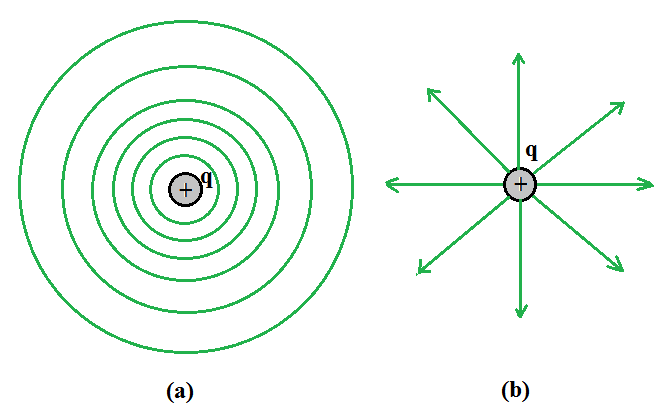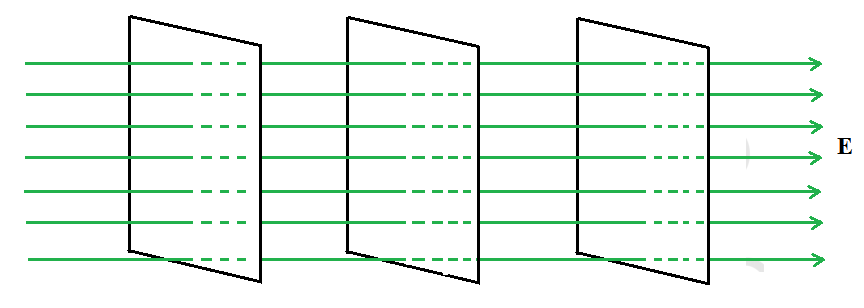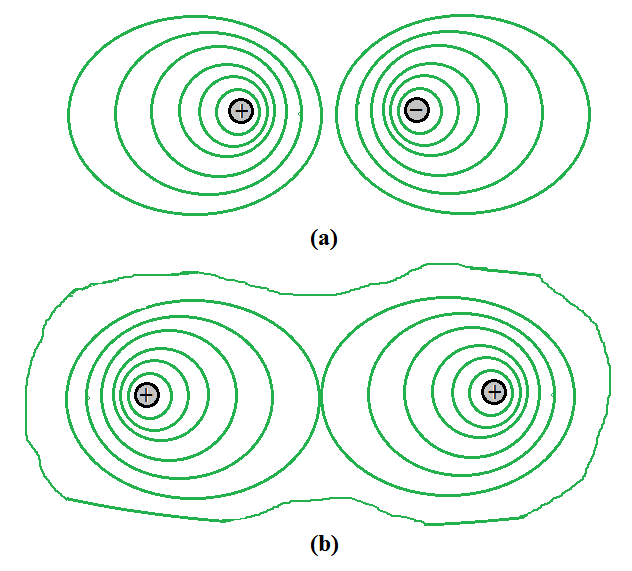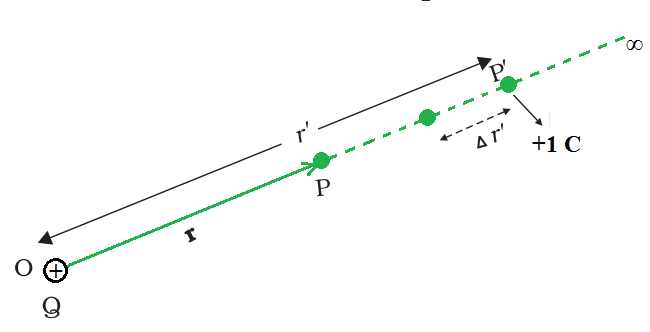等电位面
当外力做功时,将物体从一个点移动到另一个点,以抵抗弹簧力或重力等力,该功被收集或存储为物体的势能。当排除外力时,身体移动,获得动能并失去等量的势能。因此动能和势能之和是守恒的。这类力量被称为保守力量。这些力的例子是弹簧力和重力。
Coulomb force is a conservative force between two (stationary) charges. Both have an inverse-square relationship on distance and differ only in the proportionality constants. The masses in the expression of gravitational law are replaced by charges in Coulomb’s law expression. Thus, like the potential energy of a mass in a gravitational field, the electrostatic potential energy of a charge in an electrostatic field is defined.
等电位面
在表面上所有位置具有固定电位值的表面称为等电位面。对于单个电荷 q,电势可以表示为
![]()
在上面的表达式中,观察到如果 r 是常数,那么 V 也保持常数。因此,单点电荷的等势面是以电荷为中心的同心球面。

对于单个电荷 q(a) 等势面是以电荷为中心的球面,并且 (b) 电场线是径向的,如果 q > 0 从电荷开始。
根据 q 是正还是负,单个电荷 q 的电场线是在电荷处开始或结束的径向线。每个地方的电场明显垂直于通过该点的等势面。对于任何电荷排列,通过一点的等势面垂直于该位置的电场。这个断言的证明是直截了当的。
如果场不垂直于等势面,则该场沿该表面具有非零分量。将需要工作以将单元测试电荷向与场的组成部分相反的方向移动。然而,这与等势表面的定义相矛盾,该定义表明表面上任何两个位置之间都没有电位差,并且不需要做任何工作来将测试电荷移动到其上。因此,在所有点上,电场都必须垂直于等势面。除了电荷排列周围的电场线图像之外,等电位表面还允许另一种视觉图像。

均匀电场的等势面。
对于均匀电场 E,比如说,沿 x 轴,等势面是垂直于 x 轴的平面,即平行于 yz 平面的平面,如上图所示。

(a) 一个偶极子,(b) 两个相同的正电荷的一些等势面。
上图是 (a) 偶极子的等势面和 (b) 具有两个相同正电荷的等势面。
在等电位面上做功
在等势面上的两个位置之间移动电荷始终为零。在等势面上,如果点电荷从具有势能 V A 的 A点传输到具有势能 V B的 B 点,则移动电荷所做的功为
W = q(V A –V B ) = 0
因为 V A – V B = 0,
完成的总功 W 为 0。
等电位面的性质
- 等势面具有始终垂直于它的电场。
- 两个等势面不可能相交。
- 点电荷的等势面是同心球壳。
- 对于均匀电场,等势面是垂直于 x 轴的平面。
- 等电位面从高电位指向低电位。
- 空心带电球形导体内部的电势是恒定的。等电位体积可用于此。将电荷从中心移动到表面不需要做任何工作。
- 孤立点电荷的等势面是一个球体。点电荷周围存在不同的等势面,即同心球。
- 任何垂直于均匀场方向的平面都是等势面。
- 等势面之间的距离使我们能够区分强场和弱场。
电位
The amount of work required to transport a unit charge from a reference point to a specific point against the electric field is known as electric potential.
当物体逆着电场运动时,它会获得称为电势能的能量。将势能除以电荷量即可得到电荷的电势。电场的强度由电势决定。这与是否应将电荷置于电场中无关。电势是一个标量。在点电荷 +q 处,距离为 r 的所有点具有相同的电位。
物体的电势由以下因素决定:
- 一个电荷。
- 带电物体相对于其他带电物体的位置。
点电荷产生的电势
考虑点电荷 Q 的起源。取 Q 为正。使用从原点开始的位置矢量 r,我们想要找到任意点 P 的电势。为此,我们必须计算将一个单位正测试电荷从无穷远传输到点 P 所需的工作量。当 Q > 0 时,对排斥力的测试电荷所做的工作是正的。我们选择一条方便的路径——沿着从无穷远到 P 点的径向——因为完成的工作与路径无关。

将一个单位正测试电荷从无穷远处带到 P 点,抵抗电荷排斥力 Q (Q > 0) 所做的功是电荷 Q 在 P 处的电势。
在路径上某个中间点 P' 处单位正电荷上的静电力等于
![]()
在哪里 ' ![]() } 是沿 OP' 的单位向量,因此,从 r' 到 r' + Δr' 对这个力所做的功可以写成
} 是沿 OP' 的单位向量,因此,从 r' 到 r' + Δr' 对这个力所做的功可以写成
![]()
负号表示 Δr′ < 0,ΔW 为正。外力完成的总功 (W) 由上述方程两边积分确定,从 r' = ∞ 到 r' = r,
![由 QuickLaTeX.com 渲染 W=-\int_{∞}^{r} \frac{Q}{4\pi\epsilon_0r'^2}d{r'}\\ W=\left[\frac{Q}{4\pi\epsilon_0r'}\right]_∞^r\\ W=\frac{Q}{4\pi\epsilon_0r}](https://mangodoc.oss-cn-beijing.aliyuncs.com/geek8geeks/Equipotential_Surfaces_8.jpg)
由于电荷 Q 在 P 处的电位可以表示为
![]()
示例问题
问题 1:计算点 P 处 9 cm 外的 4 × 10 –7 C 电荷所产生的电势。
解决方案:
The potential at P due to the charge Q can be expressed as
![]()
Substituting the cave in the above expression,

问题 2:获得将 2 × 10 –9 C 的电荷从无穷远处带到 P 点所做的功。答案是否取决于电荷被带入的路径? (V = 4 × 10 4 V)
解决方案:
Given,
q= 2 × 10–9 C
V= 4 × 104 V
The expression for work don is
W = qV
Substitute the value in the above expression,
W = 2 × 10–9 C × 4 × 104 V
W = 8 × 10–5 J
No, the work done will be path independent. Any infinitesimal path can be broken down into two perpendicular displacements: one along to r and one perpendicular to r. The work done relation to the latter will be zero.
问题 3:确定由分别位于 (–9 cm, 0, 0) 和 (9 cm, 0, 0) 的两个电荷 7 µC 和 –2 µC(并且没有外场)组成的系统的静电势能。
解决方案:
Given,
Two charges 7 µC and –2 µC.
Distance between two points is 0.18 m.
The expression for the electrostatic potential energy is,
![]()
Substitute the value in the above expression,

问题 4:6 物质分子的永久电偶极矩为 10 –29 C m。通过施加大小为 10 6 V m –1的强静电场,一摩尔这种物质会被极化(在低温下)。场的方向突然改变了 60º 的角度。估计物质在将其偶极子沿场的新方向对齐时释放的热量。为简单起见,假设样品 100% 极化。
解决方案:
Here, dipole moment of each molecule = 10–29 Cm.
As 1 mole of the substance contains 6 × 1023 molecules.
Electrostatic field of magnitude 106 V m–1.
Total dipole moment of all the molecules can be written as
p = 6 × 1023 × 10–29 Cm
p = 6 × 10–6 Cm
Initial potential energy, Ui given by
Ui = –pE cos θ
Ui = –6×10–6×106 cos 0°
Ui = –6 J
Final potential energy (when θ = 60°), Uf
Uf = –6 × 10–6 × 106 cos 60°
Uf = –3 J
Change in potential energy = –3 J – (–6 J) = 3 J
So, there is loss in potential energy. This must be the energy released by the substance in the form of heat in aligning its dipoles.
问题 5:写出等势面的性质。
解决方案:
Following are the properties of equipotential surface.
- An equipotential surface has an electric field that is constantly perpendicular to it.
- It is impossible for two equipotential surfaces to intersect.
- Equipotential surfaces for a point charge are concentric spherical shells.
- For a uniform electric field, the equipotential surfaces are planes normal to the x-axis.
- The equipotential surface is directed from high potential to low potential.
- The potential inside a hollow charged spherical conductor is constant. Equipotential volume can be used to this. Moving a charge from the center to the surface requires no work done.
- The equipotential surface of an isolated point charge is a sphere. Different equipotential surfaces exist around the point charge, i.e. concentric spheres.
- Any plane normal to the uniform field direction is an equipotential surface.
- The distance between equipotential surfaces allows us to distinguish between strong and weak fields.